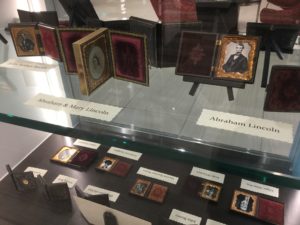Antique Photographs on Display
Gone are the days of laborious photographic processes. Most of us use cellphones rather than cameras to take photos. No doubt – and more often than not – the photos we take remain stored on electronic devices or in virtual clouds instead of tangibly tucked away in albums gracing our shelves or frames decorating our walls.
With modern technology, it’s understandably easy to forget about historic photographic processes, such as those used to make ambrotypes, CdVs, and tintypes. Fortunately, we still benefit from the results of these processes by way of antique photographs, such as those in Allen Shirley’s collection, a selection of which we’re showing now through March 2019.
Although the display is largely comprised of tintypes, a photograph made by a direct positive on a thin sheet of metal coated with a dark enamel, it includes a small selection of ambrotypes, a positive photograph on glass, and carte de visite photos, a type of small photograph patented in Paris. The photographs depict George and Martha Washington; Abraham and Mary Todd Lincoln; Edgar Allen Poe; Harriet Beecher Stowe; Frederick Douglass; Albert Einstein; Sitting Bull; Calamity Jane; Annie Oakley; the aftermath of Gettysburg and other Civil War era photographs; and more.

Library exhibitions and displays are curated by Post Art Library. Their mission is to enrich the community of Joplin by perpetuating Dr. Winfred L. and Elizabeth C. Post’s love of art, architecture, history, and history preservation through public access to arts-related library resources and services, educational programming, events, and exhibits. Visit www.postartlibrary.org for more information.


